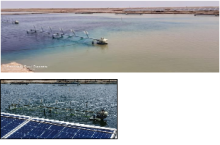Title of Process/ Know-how/ Product/Design/Equipment
Integrated System to increase solar salt yield by enhancing evaporation rate of brine using Innovative methods
Application/Uses/Problem being addressed
The demand for common salt in India is increasing by 5-6% due to industrial consumption. However, salt production faces challenges from reduced sunny days, unseasonal rains, brine dilution, and damage to harvested salt. In India, due to the drastic climate change in last four years salt production reduced up to 30 %. Land under salt production is limited to ~ 5lac acres in India. Salt production in additional land will lead to salinity ingress.
The system is to increase the salt yield from 60 to 85 tons per acres land area by applying a heat exchanger assisted by solar energy devices in brine stored in existing open salt pans itself to enhance the evaporation rate of brine during salt production process.
Salient Technical Features including Competing Features/ Impact
The integrated approach utilized
Salient features of the technology:
TRL Level & Scale of Development:
Business scope & opportunity (in terms of scale, cost, market etc.):
Annual salt demand in India is rising by 5-6%, driven largely by rise in industrial consumption, particularly for caustic soda and soda ash and exports. The salt demand is increasing and feasible coastal land is limited for salt production, which leads to the consistent increase in demand of salt and rise the salt price. The present system is to increase the salt yield by enhancing evaporation rate of brine in existing salt pond area.
The salt production quality can be increased by reducing salt cycle duration by 30-40 % compared to natural solar evaporation.
Environmental Considerations:
This is an eco-friendly process. Completely based on renewable energy / solar energy
Status of Licensing:
Ready for transferStatus of Commercialization:
Not applicableMajor Raw Materials Needed
Sea water/Subsoil brine, Fresh water
Major Plant Equipment and Machinery Required
Solar device, Brine pond/tank, Hollow tubes, Rotameter, Thermocouple, Pump, Solar panel, Overhead tank, hollow pipes, Motor, VFD, Gear Box, Gudder
Techno-Economics
Technology Package













